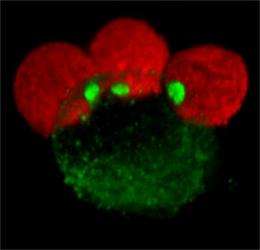HIV havens: Researchers find new clues about how HIV reservoirs may form

Much like cities organize contingency plans and supplies for emergencies, chronic infectious diseases like HIV form reservoirs that ensure their survival in adverse conditions. But these reservoirs—small populations of viruses or bacteria of a specific type that persist despite attack by the immune system or drug treatment—are not always well understood. Now, however, researchers at the California Institute of Technology (Caltech) believe they have begun to decode how a reservoir of infection can persist in HIV-positive populations.
The research team—led by David Baltimore, Robert Andrews Millikan Professor of Biology and recipient of the 1975 Nobel Prize in Physiology or Medicine—proposes that a type of HIV infection that uses infected cells to get close to uninfected cells and then discharge a large load of virus on them, may be the reason small populations of HIV-infected cells persist even when antiretroviral drug treatment has been successful in suppressing most other infections within an individual.
Their findings were reported in the advance online publication of the journal Nature on August 17.
For chronic infections such as HIV, the end game for scientists is to remove "chronic" from the disease's name—by finding a cure. Many believe that better understanding of viral reservoirs may be the key to eradicating them, and thus the disease. So the research team started at the beginning of the process, looking for clues into how an HIV reservoir might be formed in the first place.
There are two known ways that HIV can infect cells, and thus the human body: cell-free transmission, in which the virus infects immune system cells called T cells it encounters while floating free in plasma; and cell-to-cell transmission, in which the virus moves between T cells by using an infected "donor" cell as its vehicle. Once an uninfected target cell is found, the donor cell can then directionally discharge its viral load upon the target. To replicate both types of transmission, the team infected target cells using both cell-free HIV and previously infected donor cells. They used donor cells that lack a natural marker, HLA-A2, usually used in matching human organ donors to recipients. The target cells did have the marker, and this helped the scientists keep track of which cells were the donors and which were the targets. The target cells were infected either in the absence or in the presence of antiretroviral drugs.
What the researchers found was that while the antiretroviral drugs caused a steep drop in the number of newly infected cells infected via cell-free transmission, the decrease in the number of newly infected cells for the cell-to-cell infected T cells was much more moderate, even when they had large doses of the drugs thrown at them.
"We saw that with cell-to-cell infection, you wind up with a lot more virus infecting a single cell," explains Alex Sigal, a postdoctoral scholar in Baltimore's laboratory and lead author of the study. "When this happens, the chance of at least a single virus getting past the drugs is much larger."
This may explain why, while antiretroviral drugs work very well, they do not eradicate the infection completely. The drugs are probabilistic by nature, meaning that they don't kill 100 percent of the virus. So, as the number of transmitted viruses gets larger, the chance of at least one virus slipping by the drugs and infecting another cell becomes greater. "And you only need one virus to infect a cell and keep the cycle going, forming a reservoir of infection," says Sigal.
Another possibility for why HIV cannot be eradicated is that it goes into latency. A latent reservoir would consist of cells that contain the HIV virus in their DNA, but are not currently making any virus and therefore are not affected by drugs. Sigal says it's possible that both types of reservoirs are present and interact with each other.
"It's important to determine whether or not cell-to-cell replication is causing a reservoir, particularly in terms of finding a cure," he says. "You can't treat it the same way as you would a latent reservoir." Theoretically, virus in a latent reservoir could be eradicated by flushing out the virus from the cells by activating it, and treating the patient with a lot of drugs at the same time so that the released virus can't enter new cells. This would not work if the virus could get into new cells anyway, despite the drugs.
"For us, the next step is to look at the process on a more physiological level by looking at how HIV infects in organs such as lymph nodes where cell-to-cell transmission actually happens," says Sigal. The team will do so by collaborating with the UCLA Center for AIDS Research, which provided the cells for virus infection from anonymous healthy volunteers in this study. The two groups will work together to increase the level of complexity in additional studies that will aim for a deeper understanding of the reservoir. "We're really looking for a cure, but to get to a cure, you have to fully understand the disease first," he says.
More information: The Nature paper is titled "Cell-to-cell spread of HIV permits ongoing replication despite antiretroviral therapy."















